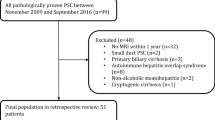Abstract
Background
Even when histologic findings are highly suggestive of primary sclerosing cholangitis (PSC), cholangiographic correlation is required for the diagnosis. The present gold standard, endoscopic retrograde cholangiopancreatography (ERCP), is invasive and associated with complications.
Objective
To evaluate the usefulness of magnetic resonance cholangiopancreatography (MRCP) in diagnosing PSC in children.
Materials and methods
MRCP studies were retrospectively reviewed in 20 children with clinical suspicion of PSC and who had undergone liver biopsy. MRCP studies were considered positive or negative for PSC depending on the presence or absence of dilatation, irregularity, multifocal strictures and beading of the bile ducts.
Results
Twenty children (14 boys, 6 girls) with an average age of 13 years qualified for the study. Of 19 diagnostic MRCP studies, 16 were called positive and 3 were called negative. An overall diagnosis of PSC-positive was assigned to all 19 patients based on clinical and laboratory findings, biopsy results and cholangiographic data. Based on this overall diagnosis, MRCP was 84% sensitive and accurate to diagnose PSC in children.
Conclusion
MRCP can be a valuable tool in diagnosing pediatric PSC that can demonstrate major intra- and extrahepatic ducts in most cases. An unequivocally positive MRCP study should not be followed by ERCP for diagnosing PSC in children.





Similar content being viewed by others
References
Wilschanski M, Chait P, Wade JA et al (1995) Primary sclerosing cholangitis in 32 children: clinical, laboratory, and radiographic features, with survival analysis. Hepatology 22:1415–1422
Feldstein AE, Perrault J, El-Youssif M et al (2003) Primary sclerosing cholangitis in children: a long-term follow-up study. Hepatology 38:210–217
Majoie CB, Reeders S, Sanders JB et al (1991) Primary sclerosing cholangitis: a modified classification of cholangiographic findings. AJR 157:495–497
Vitellas KM, El-Dieb A, Vaswani KK et al (2002) MR cholangiopancreatography in patients with primary sclerosing cholangitis: interobserver variability and comparison with endoscopic retrograde cholangiopancreatography. AJR 179:399–407
Cheng CL, Fogel EL, Sherman S et al (2005) Diagnostic and therapeutic endoscopic retrograde cholangiopancreatography in children: a large series report. J Pediatr Gastroenterol Nutr 41:445–453
Fulcher AS, Turner MA, Franklin KJ et al (2000) Primary sclerosing cholangitis: evaluation with MR cholangiography – a case-control study. Radiology 215:71–80
Vitella KM, Enns RA, Keogan MT et al (2002) Comparison of MR cholangiographic techniques with contrast enhanced cholangiography in evaluation of sclerosing cholangitis. AJR 178:327–334
Textor HJ, Flacke S, Panleit D et al (2002) 3D MR cholangiopancreatography with respiratory triggering in the diagnosis of primary sclerosing cholangitis: comparison with endoscopic retrograde cholangiopancreatography. Endoscopy 34:984–990
Ferrara C, Valeria G, Salvolini L et al (2002) MR cholangiopancreatography in primary sclerosing cholangitis in children. Pediatr Radiol 32:413–417
Bjornsson E, Olsson R, Bergquist A et al (2008) The natural history of small duct primary sclerosing cholangitis. Gastroenterology 134:975–980
Bjornsson E, Boberg KM, Cullen S et al (2002) Patients with small duct primary sclerosing cholangitis have a favorable long term prognosis. Gut 51:731–735
Kaplan GG, Laupland KB, Butzner D et al (2007) The burden of large and small duct primary sclerosing cholangitis in adults and children: a population-based analysis. Am J Gastroenterol 102:1042–1049
Moff SL, Kamel IR, Eustace J et al (2006) Diagnosis of primary sclerosing cholangitis: a blinded comparative study using magnetic resonance cholangiography and endoscopic retrograde cholangiography. Gastrointest Endosc 64:219–223
Delaney L, Applegate KE, Karmazyn B et al (2008) MR cholangiopancreatography in children: feasibility, safety, and initial experience. Pediatr Radiol 38:64–75
Revelon G, Rashid A, Kawamoto S et al (1999) Primary sclerosing cholangitis: MR imaging findings with pathologic correlation. AJR 173:1037–1042
Ito K, Mitchell DG, Outwater EK et al (1999) Primary sclerosing cholangitis: MR imaging features. AJR 172:1527–1533
Batres LA, Russo P, Mathews M et al (2005) Primary sclerosing cholangitis in children: a histologic follow-up study. Pediatr Dev Pathol 8:568–576
Author information
Authors and Affiliations
Corresponding author
Rights and permissions
About this article
Cite this article
Chavhan, G.B., Roberts, E., Moineddin, R. et al. Primary sclerosing cholangitis in children: utility of magnetic resonance cholangiopancreatography. Pediatr Radiol 38, 868–873 (2008). https://doi.org/10.1007/s00247-008-0918-6
Received:
Revised:
Accepted:
Published:
Issue Date:
DOI: https://doi.org/10.1007/s00247-008-0918-6




